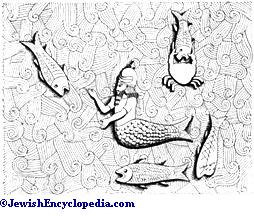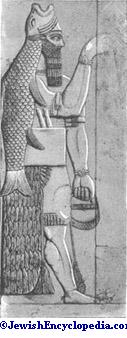DAGON (Hebrew,  ):
):
Philistine god, referred to in Judges xvi. 23; I Sam. v. 2-5; and I Macc. x. 83, xi 4; but not in Isa. xlvi. 1, where Δαγων, in "Cod. Alex.," is a mistake for αβά; nor in I Chron. x. 10, where  is a corruption of
is a corruption of  (I Sam. xxxi. 10). The extent of the worship of Dagon is also indicated by the name "Beth-dagon," designating (Josh. xv. 41) one of the towns of the Shefela, and another on the boundary of the territory of Asher (ib. xix. 27). The inscription of the Phenician king Eshmunazar also mentions "towns of Dagon" (line 19). The significance of this god can be gathered with sufficient certainty from his name and from the plastic representations of him: for
(I Sam. xxxi. 10). The extent of the worship of Dagon is also indicated by the name "Beth-dagon," designating (Josh. xv. 41) one of the towns of the Shefela, and another on the boundary of the territory of Asher (ib. xix. 27). The inscription of the Phenician king Eshmunazar also mentions "towns of Dagon" (line 19). The significance of this god can be gathered with sufficient certainty from his name and from the plastic representations of him: for  is most probably a derivative of
is most probably a derivative of  ("fish"), just as
("fish"), just as  (Sidon) is derived from
(Sidon) is derived from  ("booty") and
("booty") and  (Samson) from
(Samson) from  ("sun"); and it is probable that "Odakon" ('Ωδάκων), by which the Chaldean Berosus designates a personification of Oannes, who is supposed to rise out of the Persian Gulf, is identical with "Dakon," probably changed into "Odakon" through the similarity in sound to "Oannes."
("sun"); and it is probable that "Odakon" ('Ωδάκων), by which the Chaldean Berosus designates a personification of Oannes, who is supposed to rise out of the Persian Gulf, is identical with "Dakon," probably changed into "Odakon" through the similarity in sound to "Oannes."

It is, furthermore, by no means certain, notwithstanding G. F. Moore in "Encyc. Bibl." i. 985, that Dagon, the Odakon just mentioned, and the Assyrian god Dakan-Dagan stood in no relation with one another. Indeed, it is quite possible, as some scholars have suggested, that the figures of Dagon found on Babylonian gems, on an Assyrian cylinder, on a piece of sculpture from Khorsabad, on a similar piece from Nimrud, and on a Babylonian cylinder (compare the reproductions of these figures, especially in H. Clay Trumbull's "Jonah in Nineveh," 1892, p. 19), combining in different ways the body of a man and of a fish, are simply different representations of the god Dakan-Dagan (see Friedrich Delitzsch in Calwer, "Bibellexikon," s.v. "Dagon"; Layard's "Nineveh," 1849, ii. 466 et seq.). Neither is it contradicted by what is said in I Sam. v. 4 about the figure of the god Dagon, for the Assyro - Babylonian images also show the head and hands of the god. In this case, Dagon personifies the idea that the ocean, with its wealth of fish, was worshiped as the chief source not only of human nourishment, but also of human culture (compare Berosus' interesting amplifications of this idea in Trumbull, l. c. pp. 8-11). The same god would naturally be worshiped both near the Persian Gulf and on the Mediterranean Sea. The El-Amarna tablets indicate an intercourse at an early period between the regions along the Euphrates and Tigris, and those of western Asia and Egypt.

As regards the worship of Dagon, very little is known. Details of the construction of his "house," mentioned in Judges xvi. 26 et seq. and in I Sam. v. 1 et seq., are likewise uncertain; and the only feature of the ritual to which reference is made (I Sam. v. 4 et seq.; compare Zeph. i. 9) is the fear of touching the threshold of his temple. Dagon's temple at Ashdod was burned by the Maccabee Jonathan (Josephus, "Ant." xiii. 4, § 5). See Threshold, Sacredness of the.
